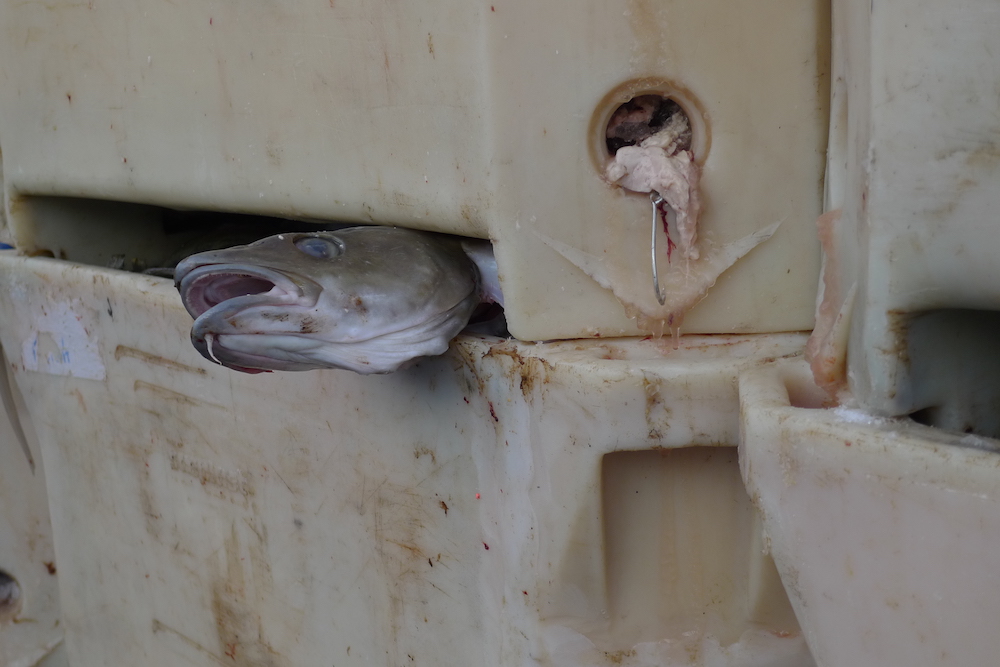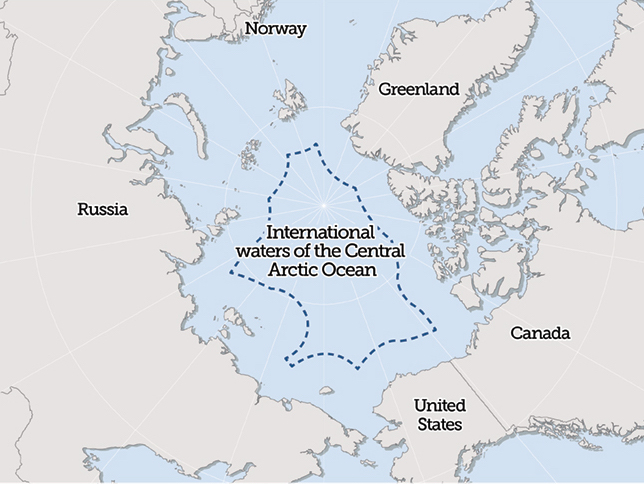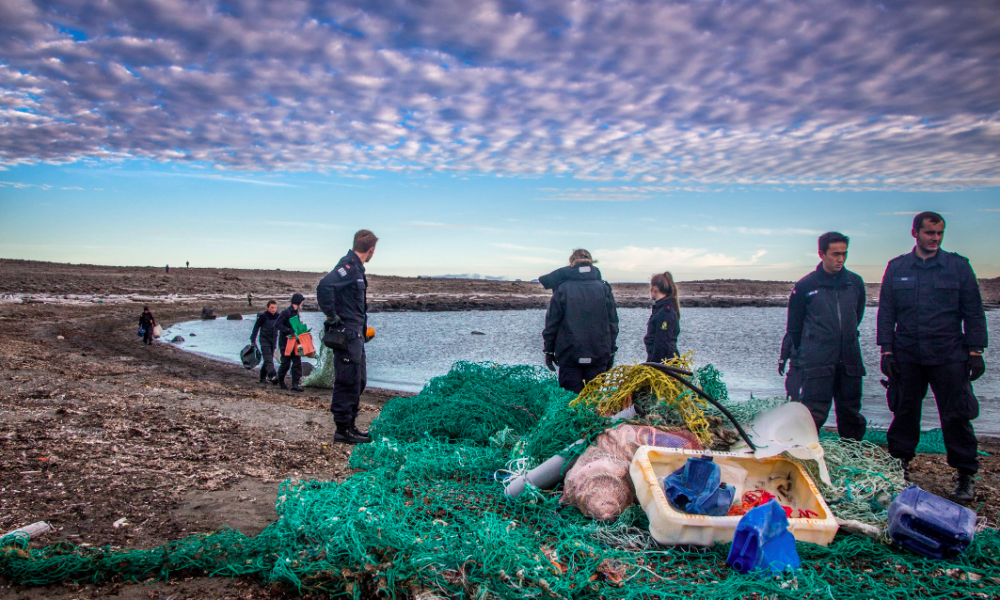The Week Ahead: Plenty more than fishing in the sea
An agreement on Arctic fisheries puts science ahead of commerce. Politics may be a by-catch.

Since 2011, there have been four international agreements relating to the Arctic, covering science, shipping, maritime pollution and search-and-rescue. A fifth, dealing with fishing, will be signed on Wednesday, October 3, in Ilulissat, Greenland.
There is currently no commercial fishing in the central part of the Arctic Ocean, in the area beyond the exclusive economic zones of the five bordering countries (see map below). Nor is there likely to be any in the near future. The expectation is that, at some point, there will be, however. The rapid decline of sea ice in recent years means that nearly half of the Arctic high seas are now ice-free in the summer. If the trend continues, fishing there is inevitable.
The most immediate impact of the fisheries agreement is straightforward, then: It postpones the opening of the central part of the Arctic Ocean for at least 16 years after coming into force. In the meantime, the 10 parties that agreed to the deal in November 2017 – the five coastal states, China, Iceland, Japan, South Korea and the EU – will be responsible for carrying out the research that will ensure that, once fishing does begin, the consequences will be fully understood and a fisheries-management regime can be established.
Other outcomes are less obvious. The non-Arctic delegations, for example, were invited to take part in negotiations on an equal footing with Arctic states. Non-Arctic states are often viewed with suspicion when they take an interest in the region, but allowing them to take part, according to David Balton, a former U.S. ambassador who led the negotiations, signifies that Arctic states accept they have a role to play.

Likewise, by agreeing not to fish until there is an agreement to do so, non-Arctic states, which typically only have a limited say, if any, in Arctic issues, will be permitted to determine the shape of the management regime.
“So, by playing be the rules of this game, they get to determine the rules of the next,” Balton says. “We gave everyone a say in the agreement. That made the non-Arctic parties partners in Arctic negotiations for the first time, which establishes their legitimacy.”
With five agreements agreed on within the span of less than a decade, the Arctic, Balton reckons, is rapidly building up a regulatory architecture. Getting in on this agreement makes it more likely non-Arctic states will have their considerations taken into account next time.
[Russian fisheries say they will safeguard Arctic stocks]
Arctic states stand to benefit as well. Because fish do not respect borders, if fishing were to begin in the international waters of the Arctic Ocean before regulations are in place it could cause stocks in the adjacent, exclusive fisheries to collapse.
“No-one can prevent countries from fishing on the high sea – not even powerful countries,” Balton says. “That is why Russia, for example, has been interested in involving non-Arctic states in part of the world they normally like to keep other countries out of.”
The task, in this case, then, is to teach others not to fish.

Putting the pieces together
On Monday, Oct. 1, Framsentret, a Norwegian research collaborative, will present the details of a five-year, three-million kroner ($370,000) program aimed at learning more about plastic in the Arctic.
Until now, the problem has been mostly a ‘I know it when I see it’ type of issue. Enough is already known about the problem to begin working on a less subjective definition, though. Carrying out more studies would add to what we know, but a better place to start, reckons Claudia Halsband, an ecologist with Akvaplan-niva, a Norwegian consultancy, who is one of the co-ordinators of Framsentret’s Plastic in the Arctic program, would be to begin working out how the pieces we do have fit together.
The program will first and foremost be a way for scientists to compare notes. Then, once they have a better picture of where plastic comes from, where it ends up and how it reacts to conditions in the North, the next step will be to inform authorities where to put their efforts.
The problem of plastic in the Arctic will not stop there, but, by telling them what the problem is and giving them suggestions for how to go about fixing it, what they need to do will be precisely defined.
Water over their dams
Talk about melting ice in Greenland and all sorts of bad things come to mind. On Oct. 1, however, the country will celebrate 25 years of turning melted ice into emission-free power.
Water from lakes formed by the natural melting of ice turns the turbines at five dams that combine to generate 70 percent of the country’s power needs, according to official statistics. To reach this stage, Greenland has invested 1 percent of its GDP in hydroelectric power each year since 1990.
Demand for hydroelectric power could rise further still, if electric vehicles become more widespread. For anyone who has tried to use a smartphone in cold temperatures, that may sound like an unlikely prospect, but electric cars fare surprisingly well in the extreme cold, and penetration rates are already relatively high. This, though, may have to do with the short driving distances in Greenland; since towns are not connected by roads, all traffic is local, and range is nothing to be anxious about. In fact, one of the biggest hurdles to expanding the use of electric cars is not their performance, but a lack of charging stations.
[Arctic renewable energy could power Europe, boost regional economies]
In the mining industry, firms are encouraged to build hydroelectric generators, rather than diesel, where possible, Doing so gives operations a greener sheen, but the energy form may itself be a draw for the most power-intensive operations. Greenland, for example, has caught the eye of aluminium firms, despite being devoid of deposits of bauxite. Refining the ore into the finished metal requires such large amounts of electricity that sailing it to Greenland solely to be processed is commercially viable. For these firms, the aim is to have their smelt powered mainly by Greenland’s melt.
The Week Ahead is a preview of some of the events related to the region that will be in the news in the coming week. If you have a topic you think ought to be profiled in a coming week, please email [email protected].